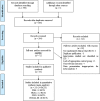Inulin-type fructans supplementation improves glycemic control for the prediabetes and type 2 diabetes populations: results from a GRADE-assessed systematic review and dose-response meta-analysis of 33 randomized controlled trials
- PMID: 31805963
- PMCID: PMC6896694
- DOI: 10.1186/s12967-019-02159-0
Inulin-type fructans supplementation improves glycemic control for the prediabetes and type 2 diabetes populations: results from a GRADE-assessed systematic review and dose-response meta-analysis of 33 randomized controlled trials
Abstract
Background: Currently, many clinical trials have shown that inulin-type fructans (ITF) supplementation is associated with glycemic control; nevertheless, the results are inconclusive. The aim of this meta-analysis of randomized controlled trials was to assess the effects of ITF supplementation on glycemic control.
Methods: PubMed, EMBASE and the Cochrane Library were searched for eligible articles up to March 6, 2019. A random-effects model was used to analyze the pooled results, and the Grading of Recommendations Assessment, Development, and Evaluation (GRADE) system was applied to assess the quality of evidence. The dose-response model was used to recommend the daily dose and duration for ITF supplementation.
Results: Thirty-three trials involving 1346 participants were included. Overall, ITF supplementation could significantly reduce concentrations of fasting blood glucose (FBG), glycosylated hemoglobin (HbA1c), fasting insulin (FINS) and homeostasis model assessment-insulin resistance (HOMA-IR). In the prediabetes and type 2 diabetes (T2DM) population, a more significant reduction in FBG [weighted mean difference (WMD): - 0.60 mmol/l; 95% CI - 0.71, - 0.48 mmol/l; high rate], HbA1c (WMD: - 0.58%; 95% CI - 0.83, - 0.32%; high rate), FINS (WMD: - 1.75 µU/ml; 95% CI - 2.87, - 0.63 µU/ml; low rate), and HOMA-IR (WMD: - 0.69; 95% CI - 1.10, - 0.28; low rate) were observed, and ITF supplementation with a daily dose of 10 g for a duration of 6 weeks and longer was recommended. Moreover, subgroup analyses suggested that the effects of glycemic control were significantly influenced by the sex of the subjects and the type and the method of intake of ITF.
Conclusions: Our analyses confirmed that these four main glycemic indicators were significantly reduced by ITF supplementation, particularly in the prediabetes and T2DM population. Evidence supports that reasonable administration of ITF supplementation may have potential clinical value as an adjuvant therapy for prediabetes and T2DM management. Trial registration The trial was registered at PROSPERO as CRD42018115875 on November 23, 2018.
Keywords: Glycemic control; Inulin-type fructans supplementation; Meta-analysis; Prediabetes; Type 2 diabetes.
Conflict of interest statement
All the authors have read and approved the paper and declare no potential conflicts of interest in the paper. If their paper is accepted, all the authors will observe the terms of the publishing license.
The authors declare that they have no competing interests.
Figures






Similar articles
-
Effect of inulin-type fructans on blood lipid profile and glucose level: a systematic review and meta-analysis of randomized controlled trials.Eur J Clin Nutr. 2017 Jan;71(1):9-20. doi: 10.1038/ejcn.2016.156. Epub 2016 Sep 14. Eur J Clin Nutr. 2017. PMID: 27623982
-
Probiotics and synbiotics supplementation improve glycemic control parameters in subjects with prediabetes and type 2 diabetes mellitus: A GRADE-assessed systematic review, meta-analysis, and meta-regression of randomized clinical trials.Pharmacol Res. 2022 Oct;184:106399. doi: 10.1016/j.phrs.2022.106399. Epub 2022 Aug 18. Pharmacol Res. 2022. PMID: 35987483
-
Folic Acid Supplementation Improves Glycemic Control for Diabetes Prevention and Management: A Systematic Review and Dose-Response Meta-Analysis of Randomized Controlled Trials.Nutrients. 2021 Jul 9;13(7):2355. doi: 10.3390/nu13072355. Nutrients. 2021. PMID: 34371867 Free PMC article.
-
The effects of inulin-type fructans on cardiovascular disease risk factors: systematic review and meta-analysis of randomized controlled trials.Am J Clin Nutr. 2024 Feb;119(2):496-510. doi: 10.1016/j.ajcnut.2023.10.030. Epub 2024 Jan 5. Am J Clin Nutr. 2024. PMID: 38309832
-
Zinc supplementation improves glycemic control for diabetes prevention and management: a systematic review and meta-analysis of randomized controlled trials.Am J Clin Nutr. 2019 Jul 1;110(1):76-90. doi: 10.1093/ajcn/nqz041. Am J Clin Nutr. 2019. PMID: 31161192
Cited by
-
The Bioactivity and Phytochemicals of Pachyrhizus erosus (L.) Urb.: A Multifunctional Underutilized Crop Plant.Antioxidants (Basel). 2021 Dec 27;11(1):58. doi: 10.3390/antiox11010058. Antioxidants (Basel). 2021. PMID: 35052562 Free PMC article. Review.
-
Nutrition in Patients with Type 2 Diabetes: Present Knowledge and Remaining Challenges.Nutrients. 2021 Aug 10;13(8):2748. doi: 10.3390/nu13082748. Nutrients. 2021. PMID: 34444908 Free PMC article. Review.
-
Therapeutic manipulation of the microbiome in liver disease.Hepatology. 2024 Jun 26:10.1097/HEP.0000000000000987. doi: 10.1097/HEP.0000000000000987. Online ahead of print. Hepatology. 2024. PMID: 38922826
-
Natural Bioactive Compounds in the Management of Type 2 Diabetes and Metabolic (Dysfunction)-Associated Steatotic Liver Disease.Pharmaceuticals (Basel). 2025 Feb 19;18(2):279. doi: 10.3390/ph18020279. Pharmaceuticals (Basel). 2025. PMID: 40006091 Free PMC article. Review.
-
Gut microbiota and old age: Modulating factors and interventions for healthy longevity.Exp Gerontol. 2020 Nov;141:111095. doi: 10.1016/j.exger.2020.111095. Epub 2020 Sep 23. Exp Gerontol. 2020. PMID: 32979504 Free PMC article. Review.
References
-
- International Diabetes Federation. IDF Diabetes Atlas, 9th ed. Brussels, Belgium: 2019. http://www.diabetesatlas.org.
-
- Gerstein HC, Santaguida P, Raina P, Morrison KM, Balion C, Hunt D, et al. Annual incidence and relative risk of diabetes in people with various categories of dysglycemia: a systematic overview and meta-analysis of prospective studies. Diabetes Res Clin Pract. 2007;78(3):305–312. doi: 10.1016/j.diabres.2007.05.004. - DOI - PubMed
-
- Aguiar EJ, Morgan PJ, Collins CE, Plotnikoff RC, Callister R. Efficacy of interventions that include diet, aerobic and resistance training components for type 2 diabetes prevention: a systematic review with meta-analysis. Int J Behav Nutr Phys Act. 2014;11:2. doi: 10.1186/1479-5868-11-2. - DOI - PMC - PubMed
Publication types
MeSH terms
Substances
LinkOut - more resources
Full Text Sources
Medical

